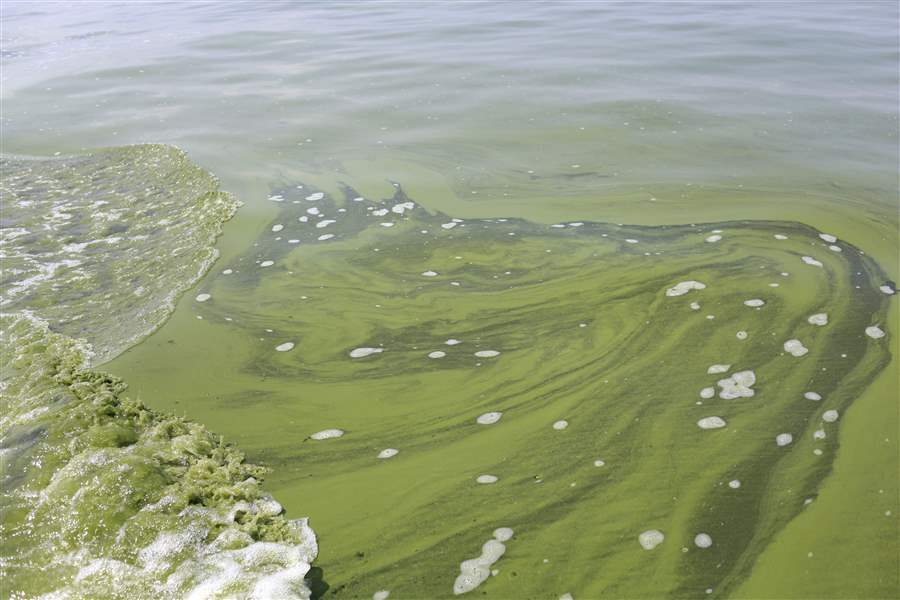
Lake Erie microcystis found in low levels
Early arrival of algae puts scientists on alert
6/18/2015
Low levels of toxins have been found in Lake Erie.
AP
Potentially toxic blue-green algae is blooming in western Lake Erie much sooner than normal this year thanks to heavy rains and warm lake water.
There’s no need to rush out for bottled water, though — at least not yet.
The concentration of microcystis is so low right now that scientists don’t even know if it’s producing the toxin microcystin yet.
There’s no sign of it at Toledo’s water intake or the city’s Collins Park Water Treatment Plant, Chuck Campbell, the city’s commissioner of water treatment, said.

Still, its earlier-than-expected arrival has put researchers on high alert.
The National Oceanic and Atmospheric Administration will begin weekly sampling of open western Lake Erie water next week. It had been planning on taking water samples twice in June, then starting its weekly regimen on July 6, Tim Davis, a research scientist at NOAA’s Great Lakes laboratory in Ann Arbor, said.
“We will be monitoring it more closely because of this,” Mr. Davis said.
Planktothrix, a microcystin-producing cousin, began growing in Lake Erie’s Sandusky Bay a few weeks ago. But that’s not a surprise: The warmth and shallowness of water there promotes growth of planktothrix from May through October, he said.
Both microcystis and planktothrix are toxin-producing forms of cyanobacteria, meaning they are genetically bacteria but commonly called blue-green algae because of their appearance and because of how they mimic algae.
Microcystis became western Lake Erie’s dominant form of blue-green algae in 1995, and has held that distinction almost annually since. It also is proliferating in other parts of the world, a sign of excessive nutrient enrichment in water globally.
Though it usually doesn’t develop in western Lake Erie until August, it has been spotted several times in July and at least once in June over the past 20 years. It often starts out in the Toledo area, where the water is shallow and warm, then moves east to about the Lake Erie islands. Scientists expect it to arrive earlier and stay longer as climate change becomes more acute.
During midday Monday, about 1 p.m., Capt. Paul Pacholski of the Lake Erie Charter Boat Association spotted what appeared to be microcystis forming a small bloom on the western Lake Erie surface, about 3.5 miles northeast of the Toledo water intake.
“You could actually take your [fishing] line and write your name in it,” Mr. Pacholski said.
Mr. Pacholski is one of about a dozen charter boat captains from the association who scoop up water samples once a week for analysis at Ohio State University’s Stone Laboratory under a program set up through the Ohio Environmental Protection Agency.
The sample Mr. Pacholski tested had a low concentration of microcystis, about 5 to 10 percent of all algae found in that sample, Justin Chaffin, Ohio Sea Grant and Stone Lab research coordinator, said.
Most of it contains diatoms, which are good forms of algae because they are part of the food chain that support fish.
Later this summer, when microcystis peaks, samples will have 100 percent of that cyanobacteria or close to it, Mr. Chaffin said.
He and others hesitated to call what Mr. Pacholski saw as an actual bloom, which is thick and fans out for miles.
Mr. Davis referred to it as a probable “scum patch.”
Lake conditions were calm at the time. The formation was not captured by daily satellite images that NOAA analyzes. As winds kicked up with storms, the algae dispersed and isn’t likely to form on the surface again until the lake settles down. The lake was so rough Wednesday that NOAA researchers postponed their planned expedition until today, Mr. Davis said.
Contact Tom Henry at: thenry@theblade.com, 419-724-6079, or via Twitter @ecowriterohio.